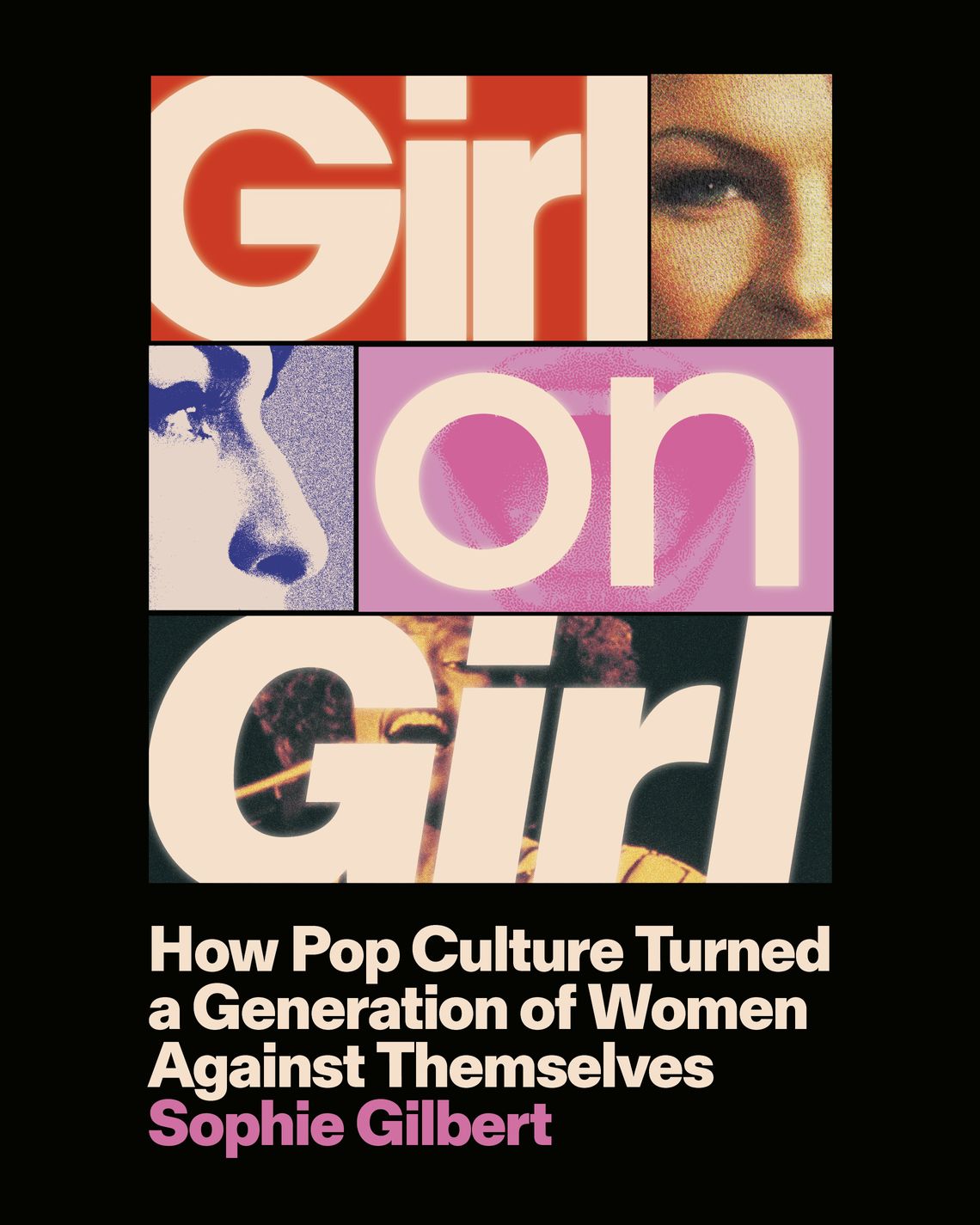
This article first appeared in Book Gossip, a newsletter about what we’re reading and what we actually think about it. Sign up here to get it in your inbox every month.
When I was 13, in 1992, the first Riot Grrrl convention was held in Washington, D.C., near where I lived. The movement formed a crucial part of how I thought about the world. Along with Hole, Tori Amos, Björk, and Liz Phair, Bikini Kill and Bratmobile made me feel good about myself, my body, and my brain. They wrote and sang about sex in a way that seemed casual, funny, and even powerful, rather than shameful or abject. Then in 1999, as I graduated high school and entered college, a huge cultural shift occurred. It was almost as if the first notes of “… Baby One More Time” brought the entire cultural edifice crumbling down — no offense to Ms. Britney Jean Spears personally intended. But it felt like I entered adolescence in a utopian moment and left it just in time for the backlash to occur. That’s where Sophie Gilbert’s new book, Girl on Girl: How Pop Culture Turned a Generation of Women Against Themselves, picks up.
In her exploration of how women were represented in the pop culture of the aughts and early 2010s, Gibert paints a somewhat grim picture. People who came of age after some of this dust settled may be shocked to realize exactly how blatantly misogynistic music, TV, and movies were during this time. I talked with Sophie about how cultural backlashes are cyclical, porn’s influence on society, how the 2010s boomlet in women’s first-person writing paved the way for Me Too, and the tiny signs of progress she sees in the culture even in these dark times.
I entered my 20s thinking that, because of my utopian years of full-on Riot Girl ’90s culture, I was inoculated. And it turns out there’s actually no effective vaccine against misogyny and internalized misogyny. Why do you think that moment of cultural backlash was so intense?
It almost made it worse, right? Because when you have a movement like that, that’s that powerful and influential to girls, it sparks a backlash because people are so enraged by it. You almost start to feel like the positive movement was counterproductive. The pattern of progress and backlash throughout the past few decades gets really exhausting to me.
What did you find in your research that surprised you the most?
I didn’t go into the book expecting porn to be such a big part of it, which I think was naïve. My mom, unfortunately, is upset that porn is such a big part of the book because she wants to tell her friends to read it and now feels like she can’t. So — sorry, mom. But it was the history.
There were moments when I really gasped because everything just seemed so intricately interconnected. There’s a chapter where I write about torture porn and the Hostel movies. And finding out that the Hostel movies were produced by Mike Fleiss, the creator of the Bachelor — that was one moment when I gasped. I found a quote in photographer Terry Richardson’s 2004 coffee table book, Terryworld, about Abu Ghraib: “You look at the images from Iraq, with that 20‑ year-old girl making prisoners masturbate for the camera. It comes from porn.” Then going full circle, I found an American Apparel ad from 2010 that had staged women models into a human pyramid, as a way of emulating one of the really obscene photos from Abu Ghraib.
It was all coming from porn. It was all coming from the cheapness of the ways models were being treated as faceless, nameless commodities. Jumble them all together in a giant human pyramid to sell T-shirts.
Were you ever worried about being so critical of porn?
I think I told my editor a few times, “I really don’t want to seem like a boring scold. That’s not how I feel.” But at the same time, it was revelatory to me to see how much porn had influenced everything in our culture in ways no one had really processed.
Between 1986 and 1996, the number of porn VHS rentals went from 60 million a year to 700 million a year. That was before the internet and then obviously the internet came along and suddenly everyone was watching porn. There’s no way that wouldn’t influence our culture.
I’m not opposed to porn at all, but what I studied during my research, it’s just undeniable that porn changed the terms of our relationships, of our understanding of one another, of our lives, of our love lives, of the way we relate to one another, but also our culture. It did it in this really insidious way. Porn is like reality television, and they’re both subjects I consider in the book. They’re both things that people don’t want to talk about. They’re written off as trash or people’s private business or whatever, but they’re hugely influential. So if you’re not thinking seriously about them, you’re missing a huge part of history.

I agree with so much of what you said in the book, but there’s this one part that gave me pause in your chapter that touches on the early-aughts boom in sex-worker memoirs. You give the writers credit for not glamorizing their profession and for destigmatizing this work, but you also say those books helped enshrine the idea that women’s bodies were the “ultimate millennial commodity.”
It may be an instance where two things can be true at the same time, but those books helped me understand that women’s bodies have always been seen as a commodity rather than that being something new or specific to the time period. It felt like this was something the culture was newly able to be upfront about rather than something that was merely “porno chic.” And I know “porno chic” is probably a big reason those books were sold to publishers, and probably had the kinds of covers they did, and were marketed the way they were marketed. But I guess I’m curious about how you parse that fine distinction between women’s very intentional exposure of the conditions of their subjugation and instances where women are being exploited?
The ones I was thinking about most keenly when I wrote that piece were Belle de Jour’s The Intimate Adventures of a London Call Girl, because I too had read that book and seen the Billie Piper show, and Tracy Quan’s memoir, Diary of a Manhattan Call Girl. I loved reading that book because she is totally unapologetic and very honest about what she’s doing and why she’s doing it. It’s not a memoir of pain and trauma; it’s a memoir of “this is how I do my job and make my money.” Especially with these books, I really, really don’t want to indict them individually. I think it’s more like trying to get at what the entirety of living through everything culturally in this moment felt like.
I do remember, and I think specifically about being in the U.K. during this time, too, it’s just such a tabloid culture of lad mags, “Page Three,” you go on Big Brother and then you do a top-off shoot for a men’s magazine and then you get a big contract. It felt like those were your opportunities. It was either that or marry a footballer and get a handbag. These were our paths to fortune, our paths toward having a presence in media. What I wanted to do so much was not pick anything apart but communicate the totality of how it felt.
You know I have to ask about women’s first-person writing and how its popularity waxes and wanes over time. You resisted writing in the first person as you worked on this book, and even though you mention at times that you felt pressure to bring in your own experiences, why didn’t you want to go there?
I’ve written about myself in the past. I’m not averse to it. When I was pitching this book, every editor really saw it as more of a “memoir in essays.” And that just wasn’t what I wanted the book to be. I’m a critic; I look at things and I analyze them. The thrill I get is in making connections and making things make sense in a way that maybe hasn’t made sense to me before or maybe hasn’t even made sense to other people before. While at first, I’d been thinking of it as criticism, it’s actually ended up being more of a history book. It’s not the kind of history that people usually see as history because there’s no men in battle, there’s no geopolitics, there’s no serious currency matter or business, but it is history that had an impact on women.
The thing I really didn’t want to do was crop up throughout like Forrest Gump. Here I am, I’m seeing Amy Winehouse in a bar. Here I am, I’m getting emails from Jian Ghomeshi. But there were moments, just because I lived through this era, where my history collided with the chapters in ways I felt were worthy of consideration, and I put those in. But otherwise, I was more interested in looking outward. That’s not because I have any kind of objection to women’s first-person writing. I think it’s really powerful. After this decade of the 2000s where women were just being torn apart, torn into strips in the media, of course there was this movement to assert women’s interiority in their souls, in their feelings, in their emotional depth, in their intellectual lives, and I’m so grateful that happened.
My U.K. editor pointed out when I was working on my chapter about women auteurs that it’s highly likely that when the Me Too movement came along, women’s stories were treated seriously because there had previously been this moment of first-person narratives. I know people sometimes write them off as trauma narratives or stories of female pain, but I think that precursor movement then made it easier to listen to women, to take them at their word.
Can I ask you a question? Why do you think people got so angry at you when you wrote about yourself? Why do you think that was?
I’ve been asked that so many times over the years. I used to get upset when people asked me that because I felt like they should be asking the people who got angry at me, rather than asking me what I thought it was about my writing that made people so angry.
But I have spent a lot of time thinking about it. I still consistently write things that make some subset of people really angry. But increasingly, I have found there is maybe an equal or even greater positive response. And those responses are thoughtful and nuanced, and they come from people I respect and admire. And the negative responses have stayed so consistent over the past 20 years. They basically just all boil down to “What do you think gives you the right to speak?”
There are various different flavors of that sentiment. “What makes you qualified to be the person telling this story?” “What makes you think you’re qualified to tell any story?” “Don’t you feel you might be potentially harming the people in your life who are affected by the fact that you’re telling the story in public?” Those responses have stayed the same, whereas the positive responses have gotten more nuanced. That’s the only really good reason to do this kind of work, I think. I’m not some kind of saint, obviously I’m writing for my own selfish reasons, too, but I am always hoping for that kind of connection.
I’ve been thinking a lot about Mary Beard’s writing about the long cultural history of women being silenced. And she goes all the way back to the Odyssey where Telemachus tells his mother to shut up because the men are talking. I think it speaks to how our narratives have been written by men, historically, forever. So when women come forward and present themselves as subjects and consider themselves worthy of being subjects, there’s such outrage at the audacity of that. It’s like, “How dare you?” It’s so deep in our DNA because it’s just the way things have always been.
We are very happy to let men ramble on about their lives in seven-book series, but women get approached with much more scrutiny and disdain. There’s just this shocked surprise whenever a woman speaks. When you’re talking about the tenor of the criticism not having changed, I really think it is this millennia-old impulse. But that is heartening that it’s quieter now and that the other responses are checking it.
Are these issues inevitably cyclical? Fat phobia, for example, was just so much more blatant in the early aughts. Then there was this almost mainstream body-positivity movement. But since GLP-1’s have become nearly ubiquitous, that movement now seems like just a cruel joke. What do you make of that?
I don’t want to be like, “This is why I wanted to write the book,” but it is. I do think once you understand there’s nothing new under the sun and the same old tricks will always come up to trap you, it’s a little bit easier to resist, or at least to question.
I think certainly we don’t have the same fat phobia now that we had back then. No one’s going to publish a book called Skinny Bitch where they lambaste the reader for being a disgusting fat pig. But it’s different. I think what’s happening now is sneakier. GLP-1 drugs seem promising in so many ways. They seem to have helped so many people. And health-wise, that’s fantastic. I am worried about the cultural impact of just normalizing skinny bodies again because they’re easier to achieve than they’ve been in the past.
Even though some of these things come back in a sneakier form, maybe we gain a bit of nuance every time the same thing comes around.
I think so much of our culture is so much better. I was just thinking about movies and what happened to women in the movies of the 2000s. We were just boring scolds and sex objects. Then if you look at the Golden Globes and the Oscars this year, there were all these stories about childbirth, aging, and toxic beauty standards, and all these women in their 40s and 50s on the red carpet being nominated for the roles of their lives. That is wholly new.
The politics of this moment is horrific, and I lose sleep over it. It really does feel like what’s happening to trans people, what’s happening to immigrants and refugees, is beyond monstrous and hard to process even because it’s so awful. Also, there does seem to be a real movement to get women out of the workforce. But the difference this time, I think, is that culture is not enforcing those messages. It’s not supporting them yet.
Maybe things will change; maybe I’m being too optimistic. But I don’t see Project 2025 being reiterated in mainstream culture — maybe on podcast elements of the manosphere, and maybe YouTube is mainstream culture now and I’m being naïve. But in terms of the products women engage with, like reality shows, movies, stories, books, music, there’s so much that is better. I think you see Chappell Roan and Sabrina Carpenter and Doechii, and they’re just not letting people tell them what to do, how to behave, or how to present themselves. They don’t have to. That, for me, feels so different in such a hopeful way, that maybe if we just hold on long enough, things will swing back the other way again.
In what areas would you say we’ve made progress as a culture?
I think we have made real progress in the sense that the culture at large doesn’t license the sexualization of teenagers in a way it once did. I remember walking to the bus in my school uniform when I was 12 and being catcalled by guys in trucks and stuff. And it’s so hard not to feel that it’s your fault, that you’re doing something wrong. All these movies in the ’90s were really hung up on this fetishized idea of the teenager, the teenager who’s going to be deflowered, the knowing teenager, the innocent one. American Beauty won five Oscars.
It was just freeing to understand that none of this had really anything to do with me. It was licensed by the culture at the moment. I think that has changed. I’m not saying the impulses have gone away, but I don’t think men these days feel as free to sexualize 13-, 14-year-olds in the way they seemed apparently fine with doing in the ’90s.
I really hope today’s young people feel less shame in general. It’s just a constant buzz in our minds that distracts us from whatever else we could be doing.
It does start to feel conspiratorial if you are so focused on yourself, always so focused on other women and what they’re doing, that you’re not looking outward and thinking about what you really need, what you really want to change. But it takes a long time to figure that out. I’m still struggling with it in my 40s.






